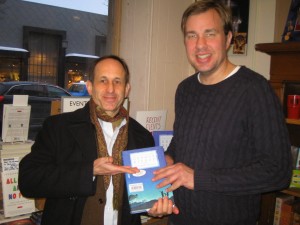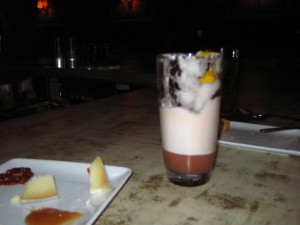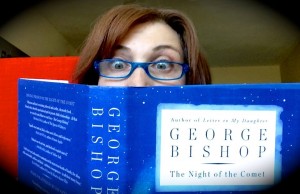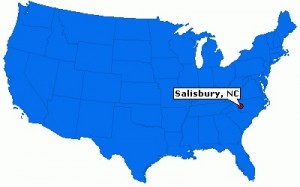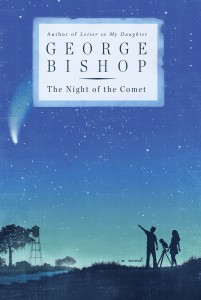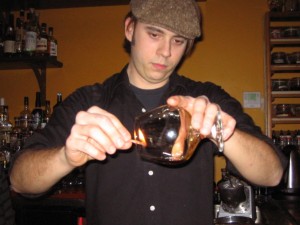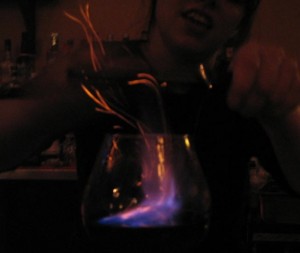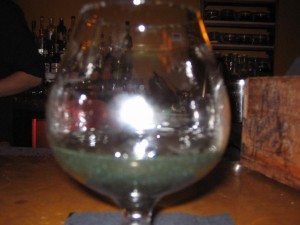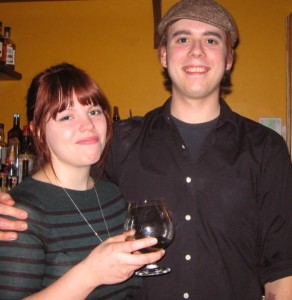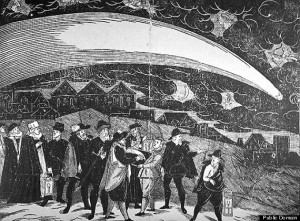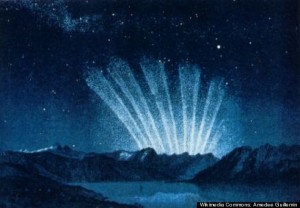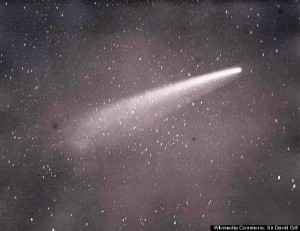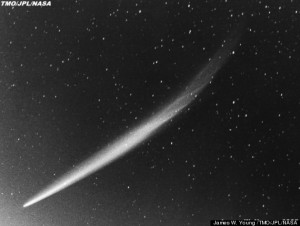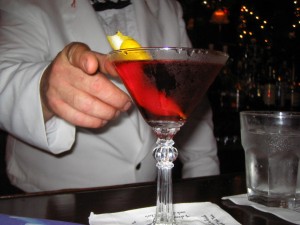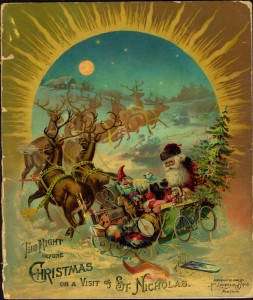George Bishop gestures dramatically to emphasize a point about “character” during a creative writing workshop at Cardinal Stritch University, Milwaukee.
The Night of the Comet
Comet Cocktail No. 5 at Bouligny Tavern
Denise at Bouligny Tavern, uptown on Magazine Street in New Orleans, whipped up the frothiest and tastiest comet cocktail yet. Here’s Denise and her drink:
It’s made with 1 oz. of Ron Zacapa dark rum, 1 oz. of ruby port, 1/2 oz. lemon juice, 1/2 oz. of simple syrup, 1 eqq white, and club soda. It tasted almost like a root beer float, only a very delicious one.
The froth represents the head of the comet, the lemon peel the tail, the white layer in the middle are clouds, and the dark ruby layer at the bottom is the New Orleans night sky.
Here’s what it looks like half gone:
One of the best things about Bouligny Tavern, by the way, besides the cool, dim, retro decor, is that the bartenders spin LPs on a stereo behind the bar. Tonight they played Paul Simon’s “Graceland,” Donovan’s “Greatest Hits,” and The Beatles “Rubber Soul.”
Carl Zeiss Planetarium Projector
The Carl Zeiss Planetarium Projector gets a cameo in THE NIGHT OF THE COMET. This is what it looks like. Kind of creepy, isn’t it?
The Theater of the Sky
Zeiss Projector, Adler Planetarium, Chicago
Date Unknown
“While the spectators sit comfortably below, as we see them here, the Planetarium, through an electric control board is caused to project upon the overarching vault an amazingly realistic representation of the pageant of the heavens.”
(Thanks to Will Amato’s FB page for this.)
COMET is Bestseller in North Carolina
Thanks to all the good folks in Salisbury, NC, who are reading THE NIGHT OF THE COMET. The Salisbury Post lists it as number 4 on their bestseller list, right between Earnest Gaines’ A LESSON BEFORE DYING and Pat Conroy’s THE DEATH OF SANTINI. Good company, I’d say.
In case you’re wondering where Salisbury, NC, is, here’s a map:
Comet Cocktail No. 4 at Maurepas Foods
The intrepid Nicola Wolf and I set out again last night in search of Comet Cocktail No. 4. We found it at Maurepas Food, in the New Orleans Bywater neighborhood.
I proposed the cocktail challenge to bartenders Tony and Lauren, two very capable and friendly people.
“See this here picture,” said I and, following my usual routine, brandished a reproduction of the cover of my famous novel, THE NIGHT OF THE COMET. “Can you do something like that?”
Tony hesitated. He wanted to take the picture home and study it for a week.
“No, no, no,” I said. “We don’t have a week. You have to do this now.”
Tony conferred with Lauren. “We’ll do it!” they said.
First they warmed a brandy snifter with hot water. We ate cheese and waited. Then Tony did something secretive with Pisco, 151 Rum, and Blue Curacao. He held a lit match to the concoction:
Watch out! Fire!
Lauren grated cinnamon over the flames, a nifty bar trick that produced a sparkly golden meteor shower above the glass:
Here’s the finished drink. It was potent and delicious. Lifted me right up into space. I got lost on my way home.
Salut, Tony and Lauren at Maurepas!
Greatest Comets of the Past 500 Years
Huffington Post has this handy recap of five of the Greatest Comets of the Past 500 Years. It’s missing some of my favorites: Donati’s Comet, the Great Comet of 1811 (featured in Tolsoy’s “War and Peace”), the phantasmagorical Great Comet of 1528, the Comet of the Black Death…
Still, there are some nice pictures. I think all of these get a mention in “The Night of the Comet.”
Greatest Comets Ever Seen In Past 500 Years
SPACE.com | By Joe Rao
Posted: 12/26/2013 9:18 am EST
When Comet ISON was discovered and a preliminary orbit for it was worked out, it was initially announced that it could be the “comet of the century.”
Of course, the 21st century is only 12 years old (from 2001) and ISON turned out to be a dud. But out there in the far recesses of space there is certainly some unknown comet worthy of such an honorific title that will ultimately put on a unique and memorable show sometime during this century.
There will always be bright and spectacular comets, but in each century there is always one that will stand above the others. Below I provide my own list of the five most spectacular comets that have appeared in each century starting from the 16th and running through the 20th century.
Take note that four of these five dazzlers appeared in the latter half of their century and that the average time between appearances amounts to 97 years. Considering that Comet Ikeya-Seki passed by in 1965, the next prospective “Comet of the Century” might not appear — according to our small sampling — until maybe 2029 at the earliest … and maybe not even until the next century (in 2103!).
Then again, stupendously bright comets are totally unpredictable and can suddenly appear at almost any time.
Greatest Comet of the 16th Century: The Great Comet of 1577
This comet passed to within 16.7 million miles (26.9 million kilometers) of the sun on Oct. 27, but was not sighted until five days later, when it was described in an account from Peru as an exceptionally brilliant object. Contemporary descriptions note that it was seen through the clouds like the moon.
The Great comet of 1577, seen over Prague on November 12. Engraving made by Jiri Daschitzky.
By Nov. 8, it was reported by Japanese observers as a “broom star,” appearing “as bright as the moon” with a white tail spanning over 60 degrees (your clenched fist held at arm’s length measures 10 degrees). The famous astronomer Tycho Brahe first saw the comet as a reflection in his garden fish pond on Nov. 13, and likened its brightness to Venus. The comet was still as bright as zero magnitude inDecember before it finally dropped below the limit of naked-eye visibility on Jan. 26, 1578. (Magnitude is a measure of a celestial object’s brightness, with smaller numbers corresponding to brighter objects.)
Greatest Comet of the 17th Century: The Great Comet of 1680
The great excitement that accompanied the first announcement of the discovery of Comet ISON was that initially its orbit appeared strikingly similar to this spectacular 17th century comet; it was hoped that perhaps ISON was either a return of this amazing object, or at the very least a large fragment. But later calculations showed this was not so.

The Great Comet of 1680 over Rotterdam. People in the drawing are using cross-staffs which were early devices for measuring angles and a predecessor of the sextant.
The German astronomer Gottfried Kirch became the first person to ever discover a comet with a telescope when he sighted this comet on Nov. 14, 1680, when it was at fourth magnitude. By Dec. 2, it already had a 15-degree tail and had reached second magnitude (as bright as Polaris, the North Star). On Dec. 18, it was at perihelion (the closest point to the sun in its orbit) coming to within 128,000 miles (206,000 km) of the sun’s surface.
At least one report (from Albany, NY) indicates that the comet was visible in the daytime. Several days later it could be seen in the evening twilight sky with a tail stretching straight up from a second-magnitude head from the southwest horizon for 70 to 90 degrees. By Jan. 10, 1681, the tail had shrunk to 55 degrees and by the Jan. 23 it measured “only” 30 degrees, with its head having faded to fourth magnitude. It remained visible to the naked eye until early February 1681.
Greatest Comet of the 18th Century: The Great Comet of 1744
First sighted on Nov. 29, 1743, as a dim fourth-magnitude object, this comet brightened rapidly as it approached the sun. Many textbooks often cite Philippe Loys de Cheseaux, of Lausanne, Switzerland, as the discoverer, although his first sighting did not come until two weeks later.
The Great Comet of 1744, or “Comet de Cheseaux-Klinkenberg”, at 4am on March 9, 1744, showing six tails rising above the horizon.
By mid-January 1744, the comet was described as first-magnitude with a 7-degree tail. By Feb. 1, it rivaled Sirius (the brightest star in the sky) and displayed a curved tail, 15 degrees in length. By Feb.18, the comet was equal to Venus in brightness and displayed two tails.
On Feb. 27, it peaked at magnitude -7 and was reported visible in the daytime, 12 degrees from the sun. Perihelion came on March 1, at a distance of 20.5 million miles (33 million km) from the sun. On March 6, the comet appeared in the morning sky, accompanied by six brilliant tails, making it resemble a Japanese hand fan.
Greatest Comet of the 19th Century: The Great September Comet of 1882
This comet is perhaps the brightest comet that has ever been seen and was a gigantic member of the Kreutz Sungrazing Group of Comets. First spotted as a bright zero-magnitude object by a group of Italian sailors in the Southern Hemisphere on Sept. 1, this comet brightened dramatically as it approached its rendezvous with the sun.
Photograph of the Great Comet of 1882, as seen from South Africa.
By Sept. 14, it became visible in broad daylight, and when it arrived at perihelion on Dec. 17, it passed at a distance of only 264,000 miles (425,000 km) from the sun’s surface. On that day, some observers described the comet’s silvery radiance as scarcely fainter than the limb of the Sun, suggesting a magnitude somewhere between -15 and -20 (the latter magnitude would register nearly 1,000 times brighter than the full moon!). The following day, observers in Cordoba, Argentina, described the comet as a “blazing star” near the sun.
The nucleus also broke into at least four separate parts. In the days and weeks that followed, the comet became visible in the morning sky as an immense object sporting a brilliant tail. Today, some comet historians consider it a “Super Comet,” far above the run of even great comets.
Greatest Comet of the 20th Century: Comet Ikeya-Seki, 1965
This was the brightest comet of the 20th century, and was found just over a month before perihelion in the morning sky, moving rapidly toward the Sun. Like the Great Comets of 1843 and 1882, Ikeya-Seki was a Kreutz Sungrazer and on Oct. 21, swept to within 744,000 miles (1.2 million km) of the center of the sun.
This picture was captured on October 30, 1965 showing the full extent of this great comet’s tail of some 30 degrees.
The comet was then visible as a brilliant object within a degree or two of the sun, and wherever the sky was clear, the comet could be seen by observers merely by blocking out the sun with their hands. From Japan, the homeland of the observers who discovered it, Ikeya-Seki was described as appearing “10 times brighter than the full moon,” corresponding to a magnitude of minus 15. Also at that time, the nucleus was observed to break into two or three pieces.
Thereafter, the comet moved away in full retreat from the sun, the head fading very rapidly, but its slender, twisted tail reaching out into space for up to 75 million miles (120 million km), and dominating the eastern morning sky right on through the month of November.
Greatest Comet of the 21st Century: TBD
ISON fizzled, so we continue to wait…
Joe Rao serves as an instructor and guest lecturer at New York’s Hayden Planetarium. He writes about astronomy for Natural History magazine, the Farmer’s Almanac and other publications, and he is also an on-camera meteorologist for News 12 Westchester, N.Y. Follow us @Spacedotcom, Facebook and Google+.
Comet Cocktail No. 3 at Arnaud’s French 75
Sorry to say I lost the napkin on which Nicola Wolf, record keeper, wrote the recipe for Comet Cocktail No. 3. But it was created by Vince of Arnaud’s French 75 Bar, and it contained gin, Campari, and, I think, creme de cassis. (This was actually his third version of the cocktail; Vince is such a perfectionist that he wouldn’t even let us taste the first two.)
Here, Vince seeks to recreate the Southern night sky in a glass. The lemon peel is the comet blazing through the sky. I can vouch that it tasted heavenly.
If you’ve never been to Arnaud’s French 75, by the way, too bad for you. Vince, the bartender has recently returned to New Orleans from San Francisco. He couldn’t stay away.
Dasher and Dancer and Prancer and Vixen . . .
. . . Comet and Cupid and Donner and Blitzen.
The good folks at the Greenfield, WI public library have thoughtfully included THE NIGHT OF THE COMET on their list of reading recommendations based on the names of Santa’s reindeers in the 1823 poem “The Night Before Christmas,” by Clement Moore. Here‘s the full list:
DASHER (Books on Running)
-Complete Book of Running – Runner’s World 796.426 RUN
-Better Training for Distance Runners – David E. Martin & Peter N. Coe 796.425 MAR
-Fundamentals of Track and Field – Gerald Carr 796.42 CAR
DANCER (Dance in DVDs)
-Singin’ in the Rain – DVD SIN
-Dance Like a Star: Salsa Lessons – DVD 793.33 SAL
-Pina: Dance, Dance, Otherwise We Are Lost – DVD 792.8
PRANCER (Horse-Related Children’s Books)
-Wonder Horse – Emily Arnold McCully PIC MCC
-Safe Horse, Safe Rider: A Young Rider’s Guide to Responsible Horsekeeping – Jessie Haas J 798.2 HAA
-Horse Heroes: True Stories of Amazing Horses – Kate Petty J 636.1 PET
VIXEN (Varieties of Foxes)
-Always Looking Up: The Adventures of an Incurable Optimist – Michael J. Fox BIO FOX, Michael J.
-The Ultimate Experience (feat. Foxy Lady) – The Jimi Hendrix Experience CD ROC HEN
-Fox Terriers: Everything About History, Care, Nutrition, Handling, and Behavior – Sharon L. Vanderlip 636.755 VAN
COMET (Books and Stories About Comets)
Comets!: Visitors from Deep Space – David Eicher & David Levy 523.6 EIC
Comets – Samantha Bonar J 523.6 BON
The Night of the Comet: A Novel – George Bishop F BISHOP, George
CUPID (Romance Fiction Audiobooks)
The Inn at Rose Harbor – Debbie Macomber CD FIC MAC
First Sight – Danielle Steel CD FIC STE
The Perfect Hope – Nora Roberts CD FIC ROB
DONNER (Fashion Books)
-Tim Gunn’s Fashion Bible: The Fascinating History of Everything in Your Closet – Tim Gunn 746.92 GUN
-Fashion Makers, Fashion Shapers: The Essential Guide to Fashion by Those in the Know – Anne-Celine Jaeger 746.92 JAE
-The Power of Style: Everything You Need to Know Before You Get Dressed Tomorrow – Bobbie Thomas 646.7042 THO
BLITZEN (Football Biographies)
-Where Men Win Glory: The Odyssey of Pat Tillman – Jon Krakauer BIO TILLMAN, Pat
-Driven: From Homeless to Hero, My Journeys On and Off Lambeau Field – Donald Driver BIO DRIVER, Donald
-Alan Ameche: The Story of “The Horse” – Dan Manoyan BIO AMECHE, Alan
Merry Christmas and Happy Holidays from everyone at Greenfield Public Library!

